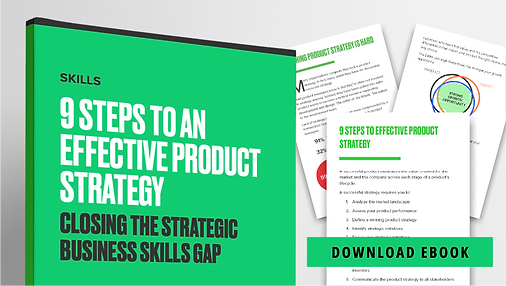Announcement text
Product Growth Strategy Framework: Second Curve & Transformational Growth
Grant Hunter
5
min read

Product managers and leaders have to make decisions and build their product growth strategy framework by looking toward the future rather than short-term successes. As a product leader, you must be willing to shift resources to start creating your next business advancement sooner rather than later.
Eleven Madison Park exemplifies a successful product growth strategy framework.
Eleven Madison Park (the three-star Michelin restaurant in NYC) has always represented the importance of transformational growth, a willingness to innovate, and start over, even when on top of the restaurant world.
Just over three years ago, a segment on CBS' Sunday Morning talked about how Eleven Madison Park, while on top of the world's restaurant game, tore everything down and started over.
Start your second curve before you hit your peak
At that time, it made me think of Charles Handy's sigmoid curve and his advice to start your second or next curve before you hit the peak of your current curve.
Well, they are doing it again.
They just announced that when they reopen from the pandemic, their menu is going to be meat-free.
Chef and owner Daniel Humm made the change as the current method of animal production and our consumption levels are not sustainable. He said, "If Eleven Madison Park is truly at the forefront of dining and culinary innovation, to me, it's crystal clear that this is the only place to go next."
The Infinite Game and Product Growth Strategy
Seeing Eleven Madison Park recreate itself again made me think of Simon Sinek's book The Infinite Game. In the book, he talks about finite games, which you play to win or lose, and infinite games, which you play to perpetuate the game.
An infinite game may have many finite games within it, but you are not judging success by winning one of those finite games but by your success across the infinite game.
For product management, this means always looking a step ahead to what will keep your product on the cutting edge of the market.
Innovate your product before it gets stale.
The reality is the Eleven Madison Park menu is a key component of their product, along with their atmosphere, service, and reputation. And what Daniel Humm (their product manager) is doing is implementing the product growth strategy framework.
He is willing to make tough decisions to start the next curve. To realize when his product has matured and not milk it but innovate it.
Eleven Madison Park – Transformational Growth
The other week, my wife and I were watching Sunday Morning on CBS, and I was interested to see their segment on the restaurant Eleven Madison Park. I know Eleven Madison Park through my research on Michelin Star restaurants in NYC, though I have had clients around the corner from it and walked by it countless times.
Start the next curve when on top.
In Spring 2017, Eleven Madison Park reached the top; not only did they have the amazing three Michelin Stars, but they were named the best restaurant in the world.
With title in hand, they decided not to rest on their laurels or get complacent; they decided it was time to tear everything out and start over.
If you are a foodie or are just interested in learning why the top restaurant in the world would do this, do yourself a favor and watch the segment, it is well worth it. For those of you who are interested in how product growth strategy framework and transformational change had a role in this business decision, keep reading.
The Sigmoid Curve (S-Curve)
Sitting there that Sunday morning (and now several more times of re-watching the segment), all I could think about was Charles Handy’s Sigmoid Curve from “The Age of Paradox,” and it got me excited (yes, I can be geeky about these types of things).
Seeing a top restaurant strive for transformational growth at the right point of its Sigmoid Curve excited me.
Why? Because it’s more common for restaurants reaching a pinnacle of success to maintain their position and offering, not to reinvent themselves.
This is no different than most businesses (organizations or people) that reach a level of success. Essentially, too many companies and or restaurants wait too long to start their Second Curve because they are focused on achievement and believing to stay there, they must continue doing what got them there. Let’s dig into the concepts.
Sigmoid Curve analyzes product lifecycle
The Sigmoid Curve is a great way to look at the lifecycle of an organization, product, or industry, with the Inception phase being where we spend our resources to create a product/business (a restaurant in this example).

After our investment (the down portion), we start seeing some initial success explode into the Growth Phase (sometimes I call it Hyper Growth – the hockey-stick portion of growth). Once our growth starts to slow, we enter the Maturity Phase, and then inevitably, the Decline stage.
The Sigmoid Curve has strong parallels to the Technology Adoption Lifecycle as defined by Everett Rogers in Diffusions of Innovation and brought back to the mainstream by Geoffrey Moore in Crossing the Chasm (the chasm would be from Inception to Growth).
The Second Curve – Transformational Growth
Handy noticed that most companies/people would wait until the decline stage was already well on its way to start their Second Curve (growth into the next paradigm).
This was the wrong time. These companies have already lost momentum, and, worse yet, in decline, there is less money to invest in the next curve.

The optimal time Handy found would be while you were still in the growth phase, around 75%-80% in.
Here you still have momentum, and you can invest in creating your second growth curves with the profits from the growth phase before they start going away in Maturity and Decline.
Eleven Madison Park invests in their second curve.
Back to Eleven Madison Park – this is exactly what they are doing.
They are still in the growth phase (conceptually) and are investing in creating the restaurant that will drive their Second Curve before the Maturity and Decline phases make them entering those phases less likely.
They are optimizing their kitchen to be more efficient and are creating a whole new dining experience that I expect will keep them on top for another decade.
Hopefully, they will be wise enough to know when to start their Third Curve, and if history is any indication of this, they likely will when the time is right.
A good product growth framework means investing in your second curve.
How does this relate to your business or product?
Do you know where you are in your S-Curve?
When do you start working on creating your Second Curve?
If you are like most companies or product managers, you probably don’t know where you are in your S-Curve.
Don’t wait until the Decline Phase to work on your Second Curve. Preemptive problem-solving and reinvention are the best ways to maintain success with your product and business.


